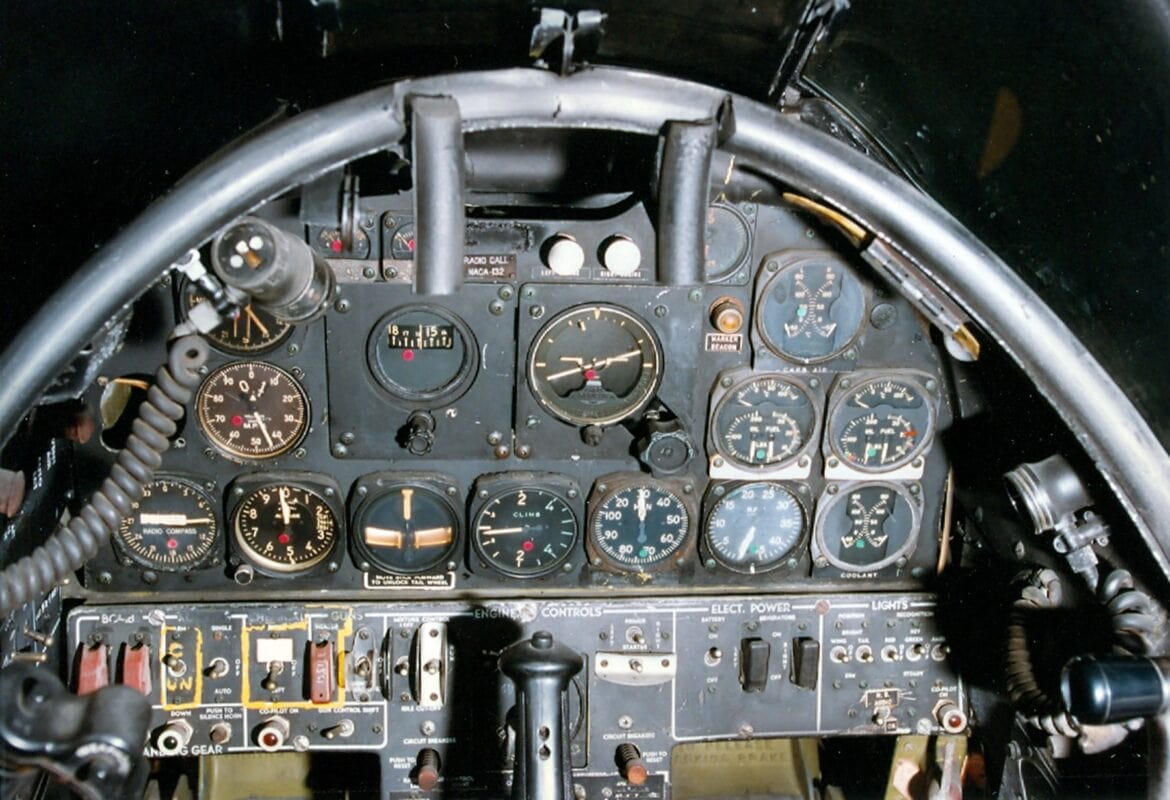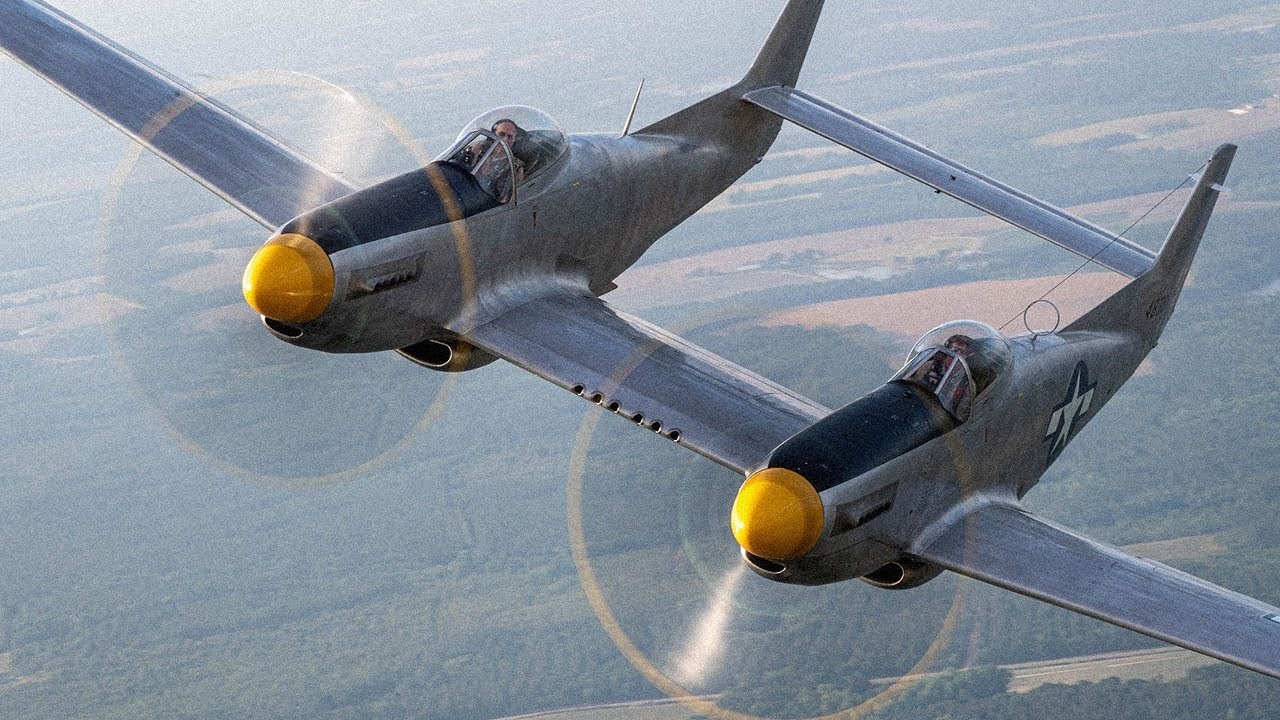Quite a few military aviation history buffs (including Yours Truly right here at 19FortyFive) have argued a case for the P-51D Mustang as the greatest fighter plane of all time. So then, going by the philosophy that “two heads are better than one,” the only thing that could be better than one Mustang would be two Mustangs … as in two Mustangs in one single plane/airframe, right? That’s apparently what the fine folks at North American Aviation (who’d already gained additional fame during WWII via the B-25 Mitchell) were thinking when they designed and built the “sequel” (so to speak) to the P-51, that being P-82/F-82 Twin Mustang. Let’s take a closer look at this aerial oddity of the early Cold War era.
The Twins Are Born
“Don’t give me an F-82/That monster from out of the blue/You won’t understand, just who’s in command/Don’t give me an F-82!” That is one of the verses from the humorous Air Force fighter pilot drinking song “Give Me Operations,” popularized by folk singers such as the late great Oscar Brand (“the Dean of American Folk Music”) and the still-alive-and-kicking Dick Jonas (retired USAF Lt. Col. AKA “the fighter pilot’s minstrel”).
When looking at pics of the Twin Mustang, one might get the impression that the plane was a result of cross-breeding the original WWII Mustang with another highly successful fighter plane from a rival American aircraft manufacturer, that being the P-38 Lightning built by famed Lockheed’s Skunk Works factory under the legendary Kelly Johnson. However, unlike the Lightning, the P-82 went beyond mere twin tails and twin-engine and actually added a second fuselage — joined by the wing and the horizontal stabilizer — a second cockpit, and a second pilot to boot. A Boeing fact sheet explains the rationale:
“With a pilot in each fuselage, it reduced the problem of pilot fatigue on ultra-long-range missions. The P-82F and G models carried a radar operator in the right cockpit instead of a co-pilot. Both engine throttles and both propellers were controllable from either cockpit by manually operated levers. The pilot’s cockpit on the left contained the normal flight and engine instruments, while the co-pilot on the right had sufficient instruments for relief and emergency operation. A simplified cockpit arrangement improved pilot comfort, including a tilting, adjustable seat to reduce fatigue during long flights.”
(NOTE: It was after WWII ended that the then-newly independent U.S. Air Force changed the alphanumeric designations for its fighter planes from “P” for “Pursuit” to “F” for ‘Fighter.)
The Twin Mustang made her maiden flight on June 15, 1945, but didn’t officially go operational until 1946. This was not in time to escort the B-29 Superfortresses on the heavy bombers’ long-range high-altitude missions over Japan — hence the rationale for the fatigue-reducing second pilot in the first place — before WWII ended, but the P-82/F-82 would more than make up for the lost time when the Korean War rolled around (more on this in a bit). The F-82 certainly didn’t fall short in the combat range department (bad pun intended), as the warplane could cover more than 1,600 miles (2,574 kilometers) with a full payload.
At a max airspeed of 475 mph (764 kph), the Twin Mustang was 35 mph (56.32 kph) faster than her single-engine predecessor. However, the P-82/F-82 did not one-up the P-51D in armament, still sticking with the six Browning .50 caliber machine guns, except this time it was decided to concentrate guns along the central joining wing span as opposed to the three guns in each wing of the “Single ‘Stang” (so to speak).
First Killer Over Korea
As previously mentioned, the Twin Mustang definitely got her fair share of action in the deadly skies over Korea after missing out on WWII aerial combat. In the process, though this twin-bodied warbird didn’t rack up quite the impressive kill tally of the P-51, she and her crews made history in terms of both firsts and lasts.
Most significantly, the F-82G scored the very first air-to-air kill of the war, on June 27, 1950. Whilst escorting a Douglas C-54 Skymaster, an F-82G piloted by then-Lt. William “Skeeter” Hudson and radio operator Lt. Carl Fraser, shot down a Yakovlev Yak-11. The next two North Korean aircraft to be shot down by U.S. forces would also fall to the guns of the F-82G. The Twin Mustang continued participating in combat operations in Korea until March 1952, although the plane would be rendered obsolete for air-to-air combat purposes as jet-vs.-jet fighter engagements rose to prominence.
As far as last hurrahs go, the F-82 turned out to be the last American piston-engined fighter ordered into production by the USAF. Five of them survive today.


DAYTON, Ohio — North American F-82B left cockpit at the National Museum of the United States Air Force. (U.S. Air Force photo)

DAYTON, Ohio — North American F-82B Twin Mustang at the National Museum of the United States Air Force. (U.S. Air Force photo)
Where Are They Now (Lotto Powerball Jackpot Edition)?
A total of 282 P-82s/F-82s were built (compared with more than 15,000 P-51s) before being retired in 1953 (the same year that the Korean armistice was signed). Five of them survive today, including one n display at the National Museum of the United States Air Force at Wright-Patterson AFB near Dayton, Ohio, And for good measure, if any of you dear readers out there just happen to have an extra $12 million laying around the house that you don’t know what to do with, you can actually purchase one of these beauties from Platinum Fighter Sales, headquartered in beautiful Redondo Beach, California.
Christian D. Orr is a former Air Force officer, Federal law enforcement officer, and private military contractor (with assignments worked in Iraq, the United Arab Emirates, Kosovo, Japan, Germany, and the Pentagon). Chris holds a B.A. in International Relations from the University of Southern California (USC) and an M.A. in Intelligence Studies (concentration in Terrorism Studies) from American Military University (AMU). He has also been published in The Daily Torch and The Journal of Intelligence and Cyber Security. Last but not least, he is a Companion of the Order of the Naval Order of the United States (NOUS).

